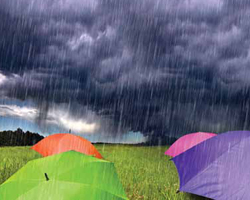It’s the season when many head for indoor venues, leaving the “great outdoors” to winter hibernation.
But for some of us, especially here in the southland, outdoor festivals are still the rage.
Although the summer thunderstorms are long gone, bad weather of other types still poses a problem.
While I’m addressing this missive primarily to the newcomers in sound reinforcement, it never hurts any of us to brush away the cobwebs and remind our brains as well.
Regardless of the time of year, weather forecasting by the technical crew still plays a big role in the continuity of any outdoor show. While I generally trust the event planning staff to keep an eye on the sky (or at least they should be), I trust my crew even more.
My company recently completed a two-weekend festival that included a dose of it all: high winds, rain, and cold temperatures made for a near impossible event. Four outdoor stages full of PA and lighting, not to mention power distribution all over the place. Nerves on edge, and of course, the cry “the show must go on” echoes from the sponsors and promoters.
To which I respond “safety first!”
Most of us working have (or should have) a clause in our agreements that provides the sound/lighting crew with at least some decision-making ability with regard to shutting down when the weather gets ugly.
This is essential when the safety of stage and performance personnel – not to mention our paying patrons – is at stake. It should be a quick but calculated decision between tech crew and event coordinators whether or not to shut down. Further, a “plan B” should always be discussed at pre-event meetings.
Getting back to that recent gig, there was no heavy rain, but drizzle combined with 35 mph winds and mid-30s (Fahrenheit) temperatures. It wasn’t quite bad enough to totally shut things down, but plenty enough to make things pretty miserable.
At times like these, I really count on my wingman – the person who watches the radar constantly on his/her PDA, shuts down the phantom power supplies on consoles without being told, is just as handy with a welder as a soldering iron, and graduated at the top of the class in knot tying. When faced with 35 mph winds, this is the person that makes sure nothing moves!
We all need someone this handy and responsible if we’re not doing it ourselves. I used to be the wingman, but when handling larger venues and festivals as the front of house guy and technical supervisor, I simply don’t have the time to run it all. Lean on the wing man – mine always seems to be one step ahead of me and that’s a good thing.
We also position easy-to-get-to road cases that are specifically labeled “weather” and stock them full of plastic sheeting, tarps, towels, and several five-gallon buckets filled with everything from carabineers and rope to bungees and ratchet straps.
Additional steel safety cables are also a must. Secure those lighting trees and trusses. Sandbag those tents and canopies.
And regardless of what anyone else says, if it’s a heavy downpour or at the first sign of lightning, shut down and cover up. Cut off power sources – literally pull the plug if that’s the situation. Clear the stage and fall zones of personnel.
Doing the extra footwork ahead of time can save a world of grief, not to mention things far worse. Here’s to a safe and prosperous 2012.
Greg Stone has worked in live sound since 1976 and is the owner of Hill Country Ears Sound Company (www.hillcountryears.com) in south Texas.















